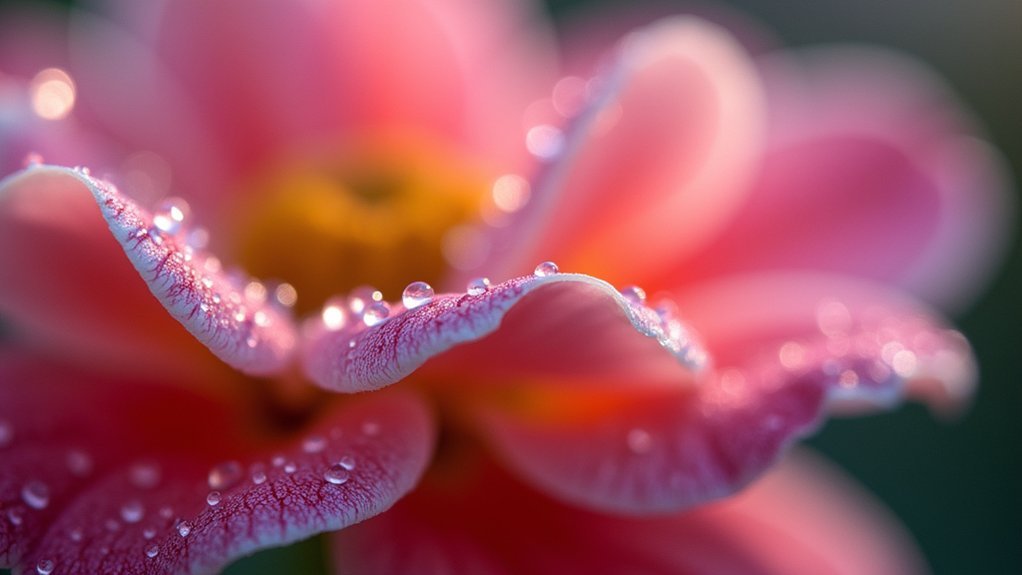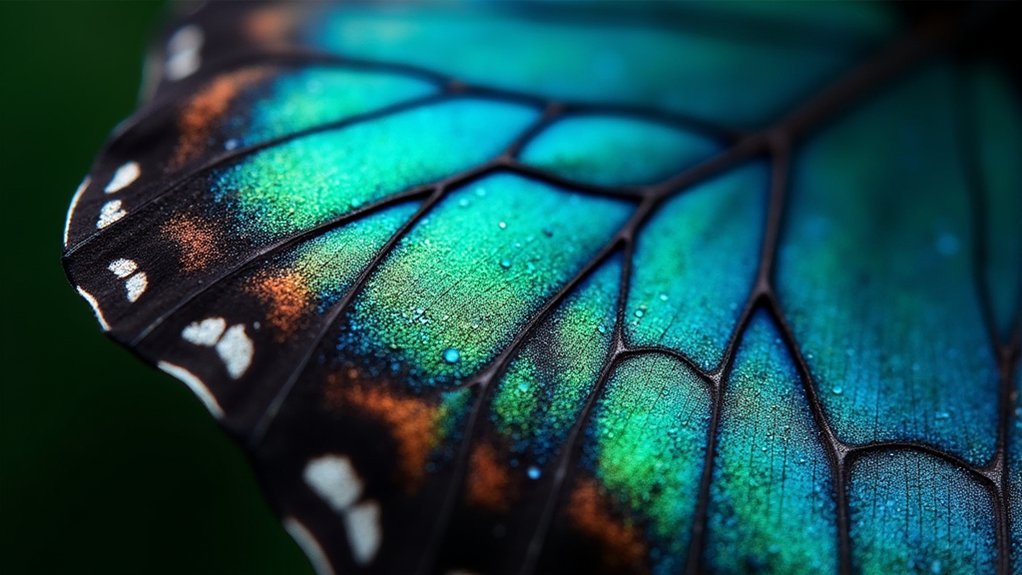For microphotography, you’ll need at least 24MP as a baseline, though 45-50MP greatly enhances detail capture, especially at magnifications beyond 1:1. Your requirements depend on your microscope type—stereo microscopes work well with 12-18MP, while compound and polarizing microscopes benefit from 24-36MP. Consider your sensor size too, as larger sensors with 4.5-5.5μm pixel pitch deliver ideal results. The relationship between resolution and magnification reveals important tradeoffs you’ll want to understand.
Understanding Pixel Density in Microphotography
When capturing the minuscule world through your lens, pixel density serves as the foundation for exceptional microphotography. Measured in pixels per inch (PPI), this critical factor determines how much fine detail your camera can record when photographing tiny subjects.
Higher pixel density directly translates to improved image quality, allowing you to capture intricate features of insects, plant cells, or other microscopic subjects with remarkable clarity. Cameras with a high pixel count of 45-50 MP offer significant advantages, enabling you to produce sharper microphotographs that maintain their detail even when enlarged or heavily cropped.
While 24 MP serves as a minimum threshold for decent microphotography, you’ll notice that higher resolution sensors reveal subtleties that would otherwise remain invisible, especially when your images are viewed at larger sizes.
Matching Camera Resolution to Magnification Levels
When you’re choosing a camera for microphotography, you’ll need to match your resolution requirements to your intended magnification level—higher magnifications demand higher pixel counts to preserve detail.
Your sensor size matters too, as larger sensors typically capture more light and produce cleaner images at higher ISOs, which is vital when working with limited light in close-up scenarios.
As you push beyond 2:1 magnification, you’ll need to balance your desire for resolution against diffraction limits, which can soften images regardless of pixel count.
Pixel Density Requirements
As you venture into microphotography, understanding the relationship between your camera’s resolution and magnification levels becomes essential for capturing crisp, detailed images.
Pixel density directly impacts your ability to produce sharp images, especially when working with highly magnified subjects.
- Higher pixel density (measured in PPI) translates to more detail in your microphotographs
- For standard microphotography, 24 megapixels typically provides sufficient detail
- At 1:1 magnification or greater, consider cameras with 45-50 megapixels for ideal results
- The higher your magnification, the more megapixels you’ll need to maintain a sharp image
- When cropping heavily (common in microphotography), higher resolution cameras preserve detail better
Remember that as you increase magnification, your pixel density requirements also increase to maintain image quality and allow for larger prints.
Sensor Size Considerations
Beyond pixel count alone, the physical dimensions of your camera’s sensor play a key role in microphotography outcomes. While sensor size doesn’t directly affect magnification capabilities, it greatly impacts how your resolution translates to image quality at high magnification ratios.
When working at 1:1 magnification or greater, you’ll need to match your sensor size with appropriate resolution. A 24-megapixel camera provides sufficient detail for standard viewing, but if you’re planning extensive cropping with extreme magnification techniques, consider cameras offering 40+ megapixels.
Remember that identical resolution on different sensor sizes will yield varying results. Larger sensors with the same megapixel count typically perform better in challenging conditions.
For static subjects, you can further enhance detail by employing multishot techniques, which maximize the benefits of your camera’s resolution regardless of sensor dimensions.
Resolution vs. Diffraction
The relationship between camera resolution and diffraction creates an essential balancing act in microphotography. When choosing your camera’s resolution, you’ll need to evaluate how diffraction limits actual detail capture at higher magnifications.
- 24 MP cameras provide sufficient resolution for most macro work while minimizing diffraction issues.
- Higher resolutions (45-50 MP) become valuable when shooting beyond 1:1 magnification.
- Stopping down beyond f/16 increases depth of field but introduces diffraction that can soften fine details.
- The benefits of higher resolution become most apparent when you need significant cropping flexibility.
- Focus stacking techniques can maximize the advantages of higher resolution sensors by combining multiple images.
Understanding this resolution-diffraction relationship helps you select equipment that matches your specific microphotography needs without wasting money on unnecessary megapixels that diffraction might neutralize.
The Impact of Sensor Size on Detail Capture
Many photographers mistakenly believe larger sensors automatically produce better macro images, but this common misconception overlooks several key factors.
Sensor size doesn’t determine how close you can get to your subject—the magnification ratio of your macro lenses does that work, typically maxing out at 1:1 reproduction.
What truly matters for capturing microscopic detail is resolution and technique. While a 47.3 MP camera will reveal more minute details than a 24 MP one, pixel density across different sensor sizes impacts overall image quality similarly.
You’ll find that proper lighting, focusing technique, and lens quality influence your results more considerably than sensor dimensions alone.
Minimum Megapixels for Scientific Microphotography
Resolution requirements become particularly important when your microphotography serves scientific purposes rather than purely aesthetic ones.
For capturing microscopic subjects with sufficient detail for analysis, you’ll need to take into account specific megapixel thresholds:
- 24 megapixels serves as the baseline for scientific microphotography, offering enough resolution for detailed capture while allowing reasonable cropping.
- 47.3 MP cameras provide enhanced clarity, particularly valuable when you need to crop extensively or produce larger prints.
- Multishot modes can boost resolution to 80-100 MP, ideal for stationary specimens.
- 12 MP might work for basic viewing but lacks the detail necessary for scientific publication.
- Higher megapixel counts directly correlate with your ability to maintain sharpness when examining intricate microscopic structures.
Resolution Requirements for Publication-Quality Images
When submitting microphotography for scientific journals or professional publications, you’ll need to meet specific resolution thresholds that guarantee your images display with maximum clarity and detail.
For publication-quality images, a minimum of 24 megapixels typically provides sufficient camera resolution to produce sharp 13×19-inch prints at the standard 300 dpi required for fine art and scientific publications.
If you’re planning extensive cropping or larger prints up to 20×30 inches, consider cameras with 45-50 megapixels.
For specialized macro photography applications, multi-shot techniques can dramatically enhance your effective resolution, producing detailed images equivalent to 80-100 megapixels.
While 12-megapixel cameras may suffice for basic viewing, they’ll limit your ability to crop without losing detail.
For most professional microphotography applications, 24-32.5 megapixels offers the ideal balance between image quality and practical file sizes.
Balancing File Size and Image Detail

Though higher resolution captures more detail in microphotography, it comes with the trade-off of larger file sizes that can quickly overwhelm your storage and slow down your workflow.
When balancing resolution against practicality, consider:
- A 24MP camera provides sufficient detail for most microphotography needs while keeping file sizes manageable.
- Stepping up to 47.3MP (like with the Lumix S1R) dramatically increases image detail but can double your storage requirements.
- For static subjects where you’re using multishot techniques, higher resolution enhances composite quality.
- You’ll need more powerful computing hardware to process higher resolution files efficiently.
- Consider your output requirements—if you’re primarily viewing digitally, the benefits of extreme resolution may not justify the file size burden.
The Role of Pixel Pitch in Microscope Imaging
Three critical factors determine the quality of your microscope images, with pixel pitch standing at the forefront. This measurement—the distance between pixel centers on your sensor—directly affects how much specimen detail you’ll capture.
| Pixel Pitch | Effect on Microphotography |
|---|---|
| 4.5-5.5 μm | Ideal balance of sensitivity and resolution |
| <4.5 μm | Higher detail but potential noise increase |
| >5.5 μm | Better in low light but less detail |
| Variable | Must match optical resolution of microscope |
When selecting a camera, you’ll need to verify compatibility between your microscope’s optical resolution and your sensor’s pixel pitch. High-resolution sensors (20+ MP) with appropriate pixel pitch will dramatically improve your ability to document fine structures, but remember that neither can compensate for limitations in the other.
Cropping Considerations for Microscopic Subjects

Beyond pixel pitch, your camera’s resolution plays an essential role in how effectively you can crop microscopic images while maintaining quality.
When working with tiny subjects, you’ll often need to crop considerably to isolate specific details.
- Higher camera resolution (24+ megapixels) allows cropping without sacrificing image detail
- For extensive cropping, consider 47.3+ megapixel cameras for maximum flexibility
- Pixel density directly impacts the sharpness retention in your cropped microphotographs
- Cropping always results in some detail loss, so starting with higher resolution provides buffer
- Multishot techniques can preserve more detail when you know you’ll need to crop heavily
Remember that your camera’s resolution establishes the baseline for how much you can crop while still producing usable images, especially when documenting microscopic specimens that require precise detail representation.
Resolution Needs for Different Microscope Types
Different microscope types demand specific camera resolution requirements to achieve ideal results. When you’re working with stereo microscopes, 12 MP cameras generally suffice, but compound and electron microscopes require substantially higher resolutions to capture fine details at high magnification.
| Microscope Type | Recommended Camera Resolution |
|---|---|
| Stereo/Dissecting | 12-18 MP |
| Compound Light | 20-24 MP |
| Polarizing | 24-36 MP |
| Electron | 36-50+ MP |
Your camera’s pixel density directly impacts the resolution of fine details in your microphotography. For scientific documentation that requires 300 dpi prints, you’ll need at least 24 MP. Remember that when working at magnifications of 100X or greater, higher resolutions of 20-50 MP will help you fully leverage your microscope’s optical capabilities.
Print Size Determinants for Microphotography
The resolution requirements we’ve discussed for various microscope types directly influence the print sizes you can achieve with your microphotography.
Understanding the relationship between megapixels and potential print dimensions helps you select the right camera for your needs:
Matching camera megapixels to your intended print size ensures your microphotography retains critical detail when displayed.
- 300 dpi is the minimum recommended resolution for high-quality microphotography prints that preserve detail.
- A 24-megapixel camera supports print sizes up to 13×19 inches (4000×6000 pixels), sufficient for most projects.
- 32.5-megapixel cameras enable larger 16×24 inch prints (4650×6975 pixels), better showcasing intricate details.
- 45-50 megapixel cameras allow for impressive 20×30 inch displays, ideal for exhibition-quality presentations.
- While scaling images from lower resolution captures is possible, you’ll sacrifice detail—starting with high resolution is always preferable.
Digital Display Requirements for Microscopic Images
When displaying your microscopic images digitally, resolution requirements differ greatly from standard photography due to the extreme detail captured at high magnifications. Your camera resolution directly impacts how these intricate features translate to screens and prints.
For ideal digital presentation, aim for a 300 dpi resolution, which fully utilizes your camera’s capabilities. This pixel density guarantees that the fine structures observed at high magnifications remain sharp and clearly defined.
With at least 24 megapixels, you’ll capture sufficient detail for standard displays, but consider 47.3 megapixels or higher if you frequently crop your images.
For large format prints (20×30 inches), you’ll need 45-50 megapixels to maintain clarity without pixelation, preserving the scientific value of your microscopic subjects.
When Higher Resolution Becomes Unnecessary
While quality microphotography demands appropriate resolution, there comes a point where adding more megapixels offers diminishing returns. When shooting macro subjects, 24MP typically provides sufficient detail without the burden of excessive file sizes.
Consider these situations where higher resolution becomes unnecessary:
- When lens quality, not sensor resolution, is the limiting factor in your macro setup
- If you’re not planning to create large-format prints exceeding 13×19 inches
- When you’re working at high magnification where technique matters more than megapixels
- If you rarely crop your microphotography images considerably
- When you prioritize depth of field control over pixel density
Future-Proofing Your Microphotography Equipment
You’ll want to contemplate not just today’s resolution requirements but what you might need in the coming years as microphotography techniques advance.
Investing in cameras with at least 47.3 MP now can save you from upgrading prematurely, especially as image processing demands increase.
New sensor technologies are continuously emerging that improve detail capture while maintaining manageable file sizes, making today’s high-resolution purchase a smart long-term decision.
Resolution For Tomorrow’s Needs
As technology continues to evolve, future-proofing your microphotography equipment requires strategic investments in camera resolution.
When planning for tomorrow’s needs, consider these essential factors:
- Start with at least 24 megapixels to guarantee flexibility for cropping without compromising image quality.
- Consider 47.3 megapixel cameras for capturing extraordinary detail in static subjects using advanced microphotography techniques.
- Explore multishot capabilities (80-100 megapixels) for unparalleled depth of field and detail capture.
- Choose 32.5 megapixel models for versatility in producing large 16×24 inch prints at professional 300 dpi quality.
- Remember that high-resolution cameras aren’t just for today’s projects—they’re investments that will meet evolving standards for years to come.
Your future self will thank you for investing in camera resolution that exceeds current requirements.
Emerging Sensor Technologies
The landscape of microphotography has been revolutionized by emerging sensor technologies that extend far beyond simple megapixel counts. Back-illuminated sensors now offer superior light sensitivity and dynamic range, capturing previously invisible details in your specimens.
Higher pixel densities combined with computational photography features like focus stacking give you unprecedented control over your microphotography workflow. You’ll benefit from resolution enhancements that push effective capture to 80-100 MP through multi-shot techniques.
| Technology | Benefit | Application |
|---|---|---|
| BSI Sensors | Enhanced sensitivity | Low-light specimens |
| Multi-shot | 80-100 MP resolution | Static subjects |
| Pixel density | Greater detail | Fine structure imaging |
| Computational | Focus stacking | Extended depth of field |
| 50+ MP sensors | Future-proofing | High-detail reproduction |
When investing in equipment, prioritize these advanced sensor capabilities to guarantee your microphotography remains cutting-edge for years to come.
Frequently Asked Questions
What Resolution Should a Camera Be for Printing?
For printing, you’ll need at least 300 dpi resolution. With 24MP, you can print up to 13×19 inches clearly, while 32.5MP allows for 16×24 inch prints. Higher resolutions enable even larger sizes.
How Many Megapixels for a Microscope Camera?
For microscope photography, you’ll want at least 12 megapixels for basic work, but 20+ megapixels is ideal if you’re doing detailed scientific analysis or planning to crop your microscope images considerably.
What Is the Best Setting for Macro Photography?
For macro photography, you’ll want 1:1 magnification lens, f/11-f/16 aperture for depth, and image stabilization or a tripod for sharpness. Consider focus stacking to overcome shallow depth of field limitations.
What Cameras Are Good for Macro Photography?
For macro photography, you’ll find the Canon EOS 90D (32.5MP APS-C) or EOS R6 Mark II with dedicated macro lenses like the RF 100mm f/2.8L excellent choices, offering the resolution and features you need.
In Summary
You’ll need to match your camera resolution to your specific microphotography goals. For casual digital viewing, 5-8MP may suffice, while scientific work demands 12-20MP minimum. Remember, it’s not just about megapixels—sensor size, lens quality, and proper technique are equally important. Don’t overspend on resolution you won’t utilize; instead, prioritize the complete system that delivers the clarity and detail your specific application requires.





Leave a Reply